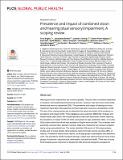Prevalence and impact of combined vision and hearing (dual sensory) impairment : a scoping review
Abstract
Hearing and vision impairments are common globally. They are often considered separately in research, and in planning and delivering services. However, they can occur concurrently, termed dual sensory impairment (DSI). The prevalence and impact of hearing and vision impairment have been well-examined, but there has been much less consideration of DSI. The aim of this scoping review was to determine the nature and extent of the evidence on prevalence and impact of DSI. Three databases were searched: MEDLINE, Embase and Global Health (April 2022). We included primary studies and systematic reviews reporting the prevalence or impact of DSI. No limits were placed on age, publication dates, or country. Only studies where the full text was available in English were included. Two reviewers independently screened titles, abstract, full texts. Data were charted by two reviewers independently using a pre-piloted form. The review identified 183 reports of 153 unique primary studies and 14 review articles. Most evidence came from high-income countries (86% of reports). Prevalence varied across reports, as did age groups of participants and definitions used. The prevalence of DSI increased with age. Impact was examined across three broad groups of outcomes-psychosocial, participation, and physical health. There was a strong trend towards poorer outcomes for people with DSI across all categories compared to people with one or neither impairment, including activities of daily living (worse for people with DSI in 78% of reports) and depression (68%). This scoping review highlights that DSI is a relatively common condition with substantial impact, particularly among older adults. There is a gap in evidence from low and middle-income countries. There is a pressing need for a consensus position on the definition(s) of DSI and standardisation of reporting age groups to enable reliable estimates to be ascertained and compared and responsive services developed.
Citation
Bright , T , Ramke , J , Zhang , J H , Kitema , G F , Safi , S , Mdala , S , Yoshizaki , M , Brennan-Jones , C G , Mactaggart , I , Gordon , I , Swenor , B K , Burton , M J & Evans , J R 2023 , ' Prevalence and impact of combined vision and hearing (dual sensory) impairment : a scoping review ' , PLOS Global Public Health , vol. 3 , no. 5 , e0001905 . https://doi.org/10.1371/journal.pgph.0001905
Publication
PLOS Global Public Health
Status
Peer reviewed
ISSN
2767-3375Type
Journal article
Description
Funding: MJB is supported by the Wellcome Trust (207472/Z/17/Z). JR's appointment at the University of Auckland is funded by the Buchanan Charitable Foundation, New Zealand. TB is funded by Christian Blind Mission (CBM International). The Lancet Global Health Commission on Global Eye Health is supported by The Queen Elizabeth Diamond Jubilee Trust, Moorfields Eye Charity [grant number GR001061], NIHR Moorfields Biomedical Research Centre, Wellcome Trust, Sightsavers, The Fred Hollows Foundation, The SEVA Foundation, British Council for the Prevention of Blindness and Christian Blind Mission. CGBJ is supported by an NHMRC Fellowship (GNT 1142897) and a WA Future Health Research and Innovation Fund Fellowship.Collections
Items in the St Andrews Research Repository are protected by copyright, with all rights reserved, unless otherwise indicated.

